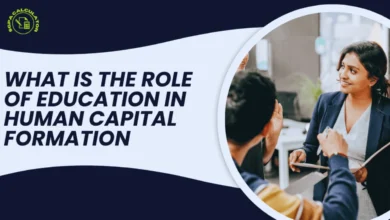Miss Circle Fundamental Paper Education – Simplified Guidance

In the realm of education, “Miss Circle Fundamental Paper Education” stands out as a critical concept for educators, students, and academic institutions alike. This system not only focuses on enhancing paper-based learning but also ensures fundamental skills are imparted seamlessly. In today’s fast-paced digital age, many educators and learners find themselves drifting away from traditional paper-based approaches. However, the timeless effectiveness of paper education cannot be overlooked. For instance, studies have shown that students often retain more information when engaging with paper materials compared to digital screens.
Miss Circle Fundamental Paper Education aims to bring simplicity back into the learning process, ensuring learners grasp the core essentials of their subjects. Whether it’s crafting detailed essays, solving math problems, or analyzing case studies, this education model prioritizes clarity and structure. Let’s dive into how this unique methodology works, its benefits, and actionable tips to apply it effectively in various academic scenarios. Below, we will explore structured insights and practical examples to make this topic relatable for everyone.
What is Miss Circle Fundamental Paper Education?
Miss Circle Fundamental Paper Education focuses on promoting paper-based learning techniques combined with structured fundamentals. Miss Circle emphasizes a return to traditional methods while integrating innovative approaches that make paper-based learning effective and engaging. Unlike digital learning, which can sometimes overwhelm with distractions, this approach emphasizes simplicity and core educational values.
| Feature | Digital Education | Paper-Based Education |
| Retention Rate | Lower due to distractions | Higher with active engagement |
| Accessibility | Limited by technology requirements | Widely available and versatile |
| Learning Speed | Faster but often superficial | Slower but deeply ingrained |
| Cost | Higher with tech devices | Affordable and long-lasting |
Why is Fundamental Paper Education Still Relevant?
In a world dominated by digital platforms, it might seem outdated to rely on paper education. For example, schools in Finland, known for their top-tier education system, integrate handwriting exercises throughout their curriculum, demonstrating the power of this fundamental approach. Yet, many academic researchers argue for its relevance due to the following reasons:
- Memory Retention: Writing by hand helps improve long-term memory.
- Elimination of Distractions: Paper eliminates notifications and multitasking temptations.
- Cost-Effective Solutions: Unlike tablets and computers, paper materials are accessible to all socioeconomic groups.
- Cognitive Development: Handwriting encourages better brain coordination and development.
How to Implement Miss Circle Fundamentals in Education
Successfully implementing Miss Circle Fundamental Paper Education involves a step-by-step approach. Here are actionable tips:
- Organize Core Materials: Teachers should prepare clear, concise notes for students.
- Set Paper Assignments: Encourage assignments written by hand to improve focus.
- Use Real-Life Examples: Incorporate scenarios students can relate to for better understanding.
- Introduce Routine Practices: Daily paper-based quizzes and brainstorming sessions can reinforce concepts.
| Steps to Implement | Advantages |
| Create structured templates | Helps organize learning efficiently |
| Assign handwritten tasks | Improves engagement and comprehension |
| Provide paper feedback | Personalized and tangible for students |
Advantages of Miss Circle Fundamental Paper Education
Adopting the Miss Circle Fundamental Paper Education approach brings a treasure trove of benefits that go far beyond the surface. Here’s why this methodology stands out in shaping well-rounded, capable learners:
- A Spark for Creativity: There’s something uniquely liberating about the tactile nature of writing. Unlike the rigid confines of typing, the flow of pen on paper encourages freeform thought, unlocking pathways to imaginative thinking. From brainstorming ideas to sketching out concepts, the creative potential here is boundless.
- Tailored Learning Experiences: Paper-based education allows for unparalleled adaptability. Teachers can customize materials, tweak lesson plans, and design assignments to align with each student’s unique pace, interests, and abilities. This personalized approach ensures no learner is left behind.
- Reviving the Art of Handwriting: In an age of keyboards and touchscreens, handwriting has become a fading skill. Yet, for young learners, developing legible, confident handwriting remains a foundational achievement. It’s more than aesthetic—it’s a cognitive exercise that reinforces memory and attention to detail.
- Unparalleled Exam Preparedness: Many high-stakes exams, from university entrance tests to professional certifications, still require paper-based answers. Structured paper education not only familiarizes students with writing detailed responses but also hones their ability to manage time effectively under pressure. Imagine a student confidently tackling an essay question or meticulously solving problems—skills polished through years of handwritten practice. By embracing these benefits, Miss Circle Fundamental Paper Education equips learners with tools that extend far beyond the classroom. It’s not just an educational approach—it’s a lifelong advantage.
Tackling Modern Educational Dilemmas: How Miss Circle Redefines Learning
In today’s fast-evolving educational landscape, challenges abound—from an overdependence on technology to waning student engagement. Miss Circle’s methodology rises to meet these obstacles, offering a grounded, transformative solution. Here’s how:
Restoring Focus in a Tech-Saturated World
The omnipresence of screens has fragmented attention spans, making sustained focus a rarity. Miss Circle’s paper-based approach cuts through the noise, creating an environment free from pop-up notifications and endless scrolling. By returning to the simplicity of pen and paper, students regain the ability to concentrate deeply and engage meaningfully.
Transforming Passive Absorption into Active Participation
Unlike passive digital interactions, paper education demands engagement. The physical act of writing, coupled with in-depth reading and critical analysis, shifts students from being mere consumers of information to active participants in their learning journey. This hands-on approach not only improves comprehension but also fosters intellectual curiosity.
Building Discipline Through Consistency
Structured, regular paper-based exercises cultivate habits of discipline, responsibility, and time management. Whether it’s completing handwritten assignments or tackling methodical practice tasks, students develop a work ethic that translates far beyond the classroom.
In a world increasingly distracted and detached, Miss Circle’s emphasis on these foundational principles is nothing short of revolutionary. By addressing the root causes of modern educational struggles, this approach ensures a more focused, engaged, and prepared generation of learners.
Practical Applications of Miss Circle Fundamental Paper Education
Miss Circle Fundamental Paper Education can be applied across various academic scenarios:
- Primary Schools: Reinforcing handwriting skills and basic concepts.
- High Schools: Preparing students for paper-based examinations.
- Workshops and Training: Encouraging participants to jot down notes manually for deeper understanding.
- Special Education Programs: Offering customized paper-based activities to suit diverse learning needs.
| Scenario | Paper-Based Solution |
| Primary handwriting practice | Practice sheets for letter formation |
| High school science prep | Handwritten lab reports |
| Adult workshops | Guided paper-based exercises |
Inspiring Students to Embrace Paper-Based Education
Shifting students toward paper-based learning isn’t just about enforcing rules—it’s about cultivating curiosity and making the process both engaging and meaningful. Success lies in a blend of creativity, encouragement, and demonstrating real-world value. Here’s how:
Infuse Fun into the Process
Paper-based education doesn’t have to feel old-fashioned or dull. Introduce dynamic activities like interactive crossword puzzles to teach vocabulary, collaborative mind-mapping sessions, or even artistic doodle challenges to enhance comprehension. By transforming learning into an enjoyable experience, students naturally gravitate toward participation.
Reward Effort with Instant Feedback
Acknowledging students’ work goes a long way in building their confidence. Highlight well-organized handwritten assignments, offer constructive feedback, and celebrate their efforts with tangible rewards like stickers, certificates, or verbal praise. Positive reinforcement not only boosts morale but also instills pride in the process of writing.
Foster a Nurturing Environment
Create a classroom culture that values progress, no matter how incremental. Celebrate milestones like improved handwriting, beautifully crafted essays, or even the smallest victories, such as completing a challenging worksheet. A supportive atmosphere fosters a growth mindset, encouraging students to persist.
Highlight Real-Life Applications
Make the relevance of these skills crystal clear. Explain how developing strong handwriting, organization, and attention to detail translates into future success—whether it’s crafting standout job applications, excelling in paper-based exams, or mastering workplace documentation. A powerful example comes from a teacher in Japan who encouraged students to write letters instead of emails. The practice not only deepened their connection to the art of expression but also underscored the personal impact of thoughtful communication.
By weaving these strategies into daily teaching practices, educators can guide students to not only adopt but also appreciate the enduring value of paper-based education. It’s not just a method—it’s a mindset shift with lasting benefits.
Comparing Miss Circle Fundamentals with Digital Learning
| Aspect | Miss Circle Fundamentals | Digital Learning |
| Engagement | Higher due to manual involvement | Lower due to multitasking |
| Accessibility | Universal and low-cost | Tech-dependent |
| Longevity of Retention | Better with handwritten work | Often short-term |
| Skill Development | Improves handwriting, focus, and clarity | Improves tech-related skills |
Why Paper Education Deserves the Spotlight: A Call to Action for Parents and Teachers
In a world increasingly dominated by screens, the responsibility of promoting paper-based education lies heavily on the shoulders of parents and teachers. Here’s how they can champion this invaluable method and inspire the next generation to embrace it:
Lead by Example: Children are natural imitators. When they observe parents meticulously organizing their schedules on paper planners or teachers sketching out lesson plans in notebooks, it sends a powerful message: paper isn’t just functional—it’s essential. Modeling this behavior reinforces the value of handwriting and tactile engagement.
Cultivate the Habit of Reflection: Encourage children to keep journals or diaries, fostering creativity, self-expression, and introspection. Journaling not only builds writing skills but also promotes mindfulness, helping young minds process their thoughts in a world often too loud to think clearly.
Equip Them with the Right Tools: Support starts with resources. Stock up on practice sheets, workbooks, or even blank notebooks designed for creative exploration. These simple yet effective tools provide a tangible canvas for learning and growth, nurturing a deeper connection between students and their studies.
When students witness the authority figures in their lives actively valuing and prioritizing paper-based methods, they’re far more likely to adopt and integrate these practices into their routines. The ripple effect of such encouragement can shape lifelong habits, fostering a generation that understands the profound benefits of going back to basics.
Overcoming Challenges in Implementing Miss Circle Fundamentals
While the Miss Circle Fundamental Paper Education system offers profound benefits, its adoption isn’t without hurdles. Let’s explore these challenges and strategies to address them head-on:
Resistance to Change: For students deeply entrenched in the digital world, shifting to a paper-based approach might feel like stepping backward. The familiarity of screens, apps, and fast-paced technology often leads to hesitation or outright resistance.
Solution: Introduce paper-based activities incrementally. Pair traditional methods with digital tools, gradually weaving handwritten exercises into the fabric of daily learning. This balance helps ease the transition while showcasing the unique benefits of both systems.
Perceived Slowness of Paper Tasks: In an age of instant gratification, the slower, deliberate pace of writing and paper activities might seem inefficient or even frustrating.
Solution: Reframe the focus from speed to depth. Highlight the importance of understanding and retention over rapid completion. Incorporating mindful practices like journaling or step-by-step problem-solving can demonstrate the long-term advantages of taking one’s time.
Limited Resources: Schools facing tight budgets or resource shortages may struggle to provide adequate paper supplies and tools to sustain this methodology.
Solution: Build bridges with local businesses, non-profits, and community organizations to secure funding or donations. Creative approaches like organizing paper drives or repurposing used paper for practice work can help alleviate resource constraints while fostering a spirit of collaboration.
By acknowledging these obstacles and addressing them strategically, the Miss Circle Fundamental Paper Education system can thrive, transforming learning experiences for students and educators alike.
Conclusion
Miss Circle Fundamental Paper Education offers an opportunity to reconnect with the roots of learning. By embracing simplicity and focusing on essential skills, this approach provides a robust framework for both students and educators. It bridges the gap between traditional and modern education, reminding us that the basics often hold the greatest power.
While digital advancements are valuable, incorporating paper education ensures learners develop foundational skills that last a lifetime. From improving memory retention to enhancing creativity, this method stands as a testament to the timeless value of handwritten learning. By implementing this system, educators, parents, and students alike can reap long-term benefits in education and beyond. The future of learning doesn’t have to abandon the past; instead, it can draw from its strengths to create a balanced and effective approach.
FAQs
What exactly is Miss Circle Fundamental Paper Education?
This methodology champions an education system centered on paper-based learning, blending time-honored traditions with forward-thinking techniques to sharpen focus, boost memory retention, and build indispensable educational skills. It’s where innovation meets the charm of pen and paper.
Why does paper-based education outshine digital alternatives?
Paper-based education trumps its digital counterpart by fostering superior memory retention, sidestepping the constant barrage of distractions inherent to screens, and remaining universally accessible and cost-effective—an unbeatable trifecta for learners worldwide.
How can educators seamlessly incorporate this method into their classrooms?
Teachers can integrate this system by designing structured, handwritten note-taking exercises, assigning engaging pen-on-paper tasks, and embedding consistent practices like daily quizzes, brainstorming sessions, and creative problem-solving drills to enrich the learning experience.
Are there obstacles to implementing this approach?
Absolutely. Hurdles such as reluctance to depart from the status quo and limited resources can arise. However, these challenges can be tackled with gradual adoption, inventive resource management, and patience-driven strategies.
Where can Miss Circle Paper Education be applied practically?
This approach finds its strength in various domains, from primary schools to high schools, workshops, and even specialized education programs. Its adaptability ensures improved learning outcomes across a spectrum of educational settings.
How does this methodology prepare students for exam success?
By prioritizing consistent handwritten practice, structured assignments, and immersive learning activities, this method equips students with the skills needed to master the rigors of paper-based examinations.
Can this system coexist with digital learning?
Absolutely! A hybrid model merges the profound benefits of paper-based education with the efficiency of digital tools, striking the perfect balance between depth and convenience.




